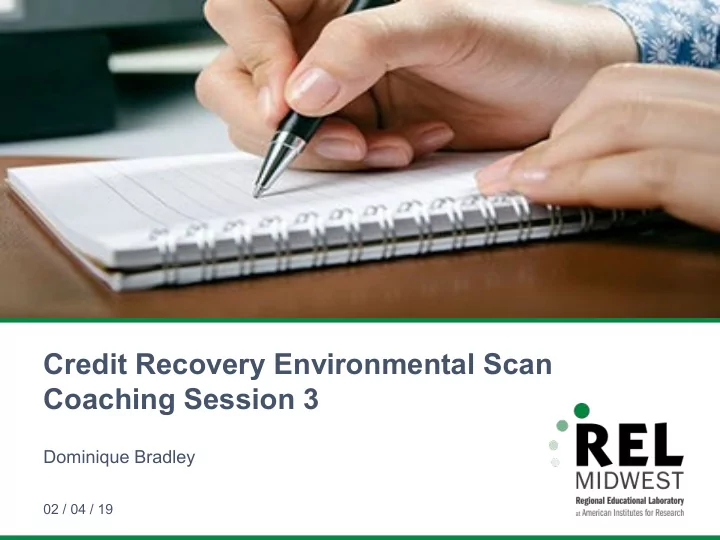

Credit Recovery Environmental Scan Coaching Session 3 Dominique Bradley 02 / 04 / 19
Agenda 1. Project progress review Understanding coding and developing a 2. coding framework 3. Next steps 4. Closing
Session goals 1. Review our progress. 2. Develop an understanding of coding. 3. Create a coding scheme. 4. Establish next steps.
Project progress review
Project process map
Phase 1: Timeline
Phase 2: Timeline
Primary research questions 1–3 Q1. What data are schools collecting and using to assess programs, identify and track students, and make programmatic decisions? Q2. How are students experiencing credit-recovery programs (identification, referral, student pathway through programs)? Q3. How are decisions being made about offering credit- recovery programs, and what staff are involved in making those decisions?
Primary research questions 4–6 Q4. What students are being served? Are there certain student characteristics associated with certain types of credit recovery? Q5. What programs are offered, and what do those programs look like in terms of structure, support, and prevalence across schools? Q6. How do the programs offered differ in implementation from the original State Approved Alternative Program (SAAP) plans?
Sampling framework
Project products Desired products from scan: Products that will help to do the following: 1) Provide information that assists with guiding policy on credit recovery. 2) Help MDE identify potential best practices for further investigation.
Roles and responsibilities REL Midwest will: • Deliver coaching sessions, including providing necessary readings and tools to complete the scan. • Conduct up to eight interviews, observe MDE interviews and focus groups, and provide feedback. • Assist MDE with developing a coding scheme. • Assist MDE in creating final report and other research products.
Roles and responsibilities MDE will: • Attend and participate in all coaching sessions. • Gather extant data as needed. • Collect new data through focus groups and interviews. • Co-develop a coding scheme. • Participate in collaborative analysis and interpretation. • Collaborate to write final report. • Provide feedback on other related project products (infographic).
Understanding and developing a coding framework
Why code? Coding is a way to organize and understand the data. It is a method to discover potential relationships between data points and unveil unexpected themes. Coding structures connect interview responses to the research questions.
What is a code? A word or short phrase that symbolically represents salient issues that arise in the interview transcripts and address the research questions. Attride-Sterling, 2001; Saldaña, 2015
How to develop a coding structure Steps to take: Transcribe interviews. Generate categories based on transcript data, previous studies, research questions or theories. Create a document with code descriptions and examples. Revisit a transcript and try out your coding scheme. Identify emergent themes. What stands out to you?
Example coding notes Lack of support. Desiring “It’s just hard to incorporate all of professional development training. these new programs that the district requests into lesson planning. We already have enough on our plates as it is. I guess it would be helpful if they actually showed us how to include these in our scheduling.” Unorganized tracking. Need/improve online platform. “I think we need a more organized way to track things. With the way technology is advancing, it’s beyond me why we still use these archaic methods.”
Take a break
Time to try it on your own!
Next steps
Next steps Discuss system of generating codebook on SharePoint. Set target date to complete interviews and coding. Set date for next meeting.
Closing
See you next time!
Meet the presenter. Dominique Bradley dbradley@air.org
Recommend
More recommend